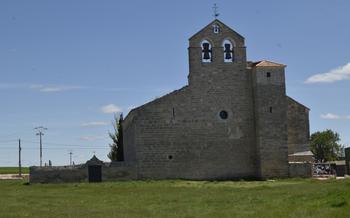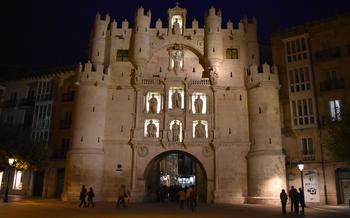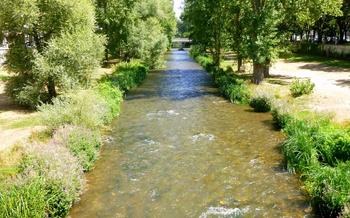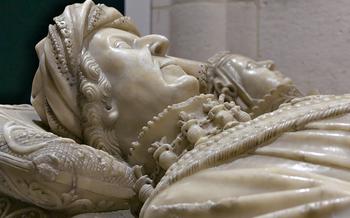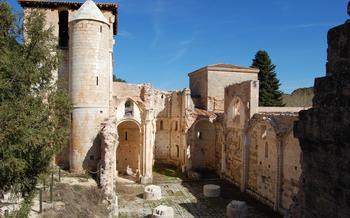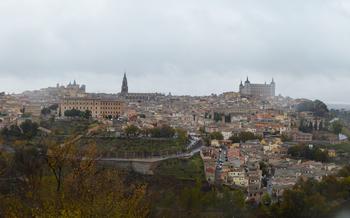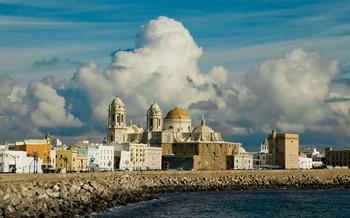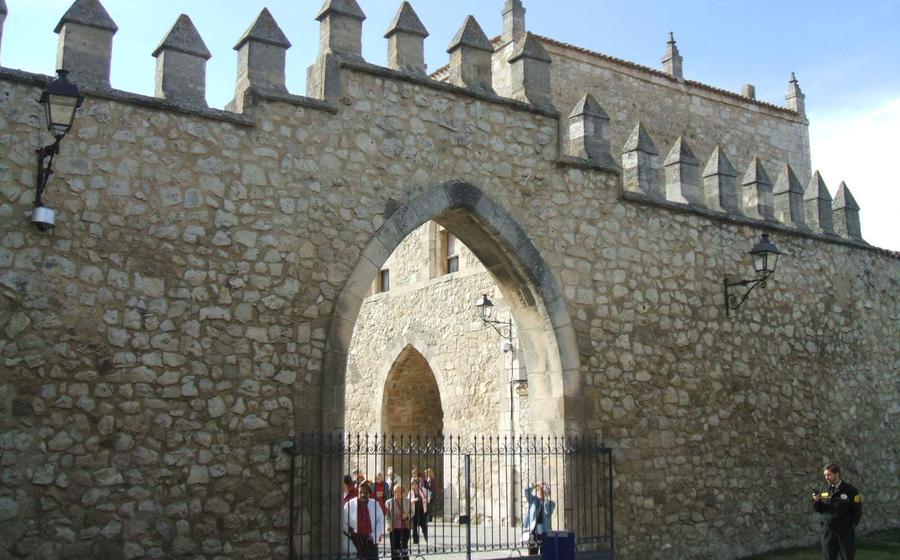
Monasterio de Santa María la Real de Las Huelgas
- A Masterpiece of Gothic and Renaissance Architecture
- Royal Pantheon of Castile
- Cistercian Order and Monastic Life
- Exploring the Monastic Complex
- The Gothic Cloister: A Serene Haven for Contemplation
- The Royal Tombs
- The Museum
- The Gardens
- UNESCO World Heritage Site
- Visiting Information
- Nearby Attractions:
- Insider Tip: Unveiling the Secret Tapestry:
A Masterpiece of Gothic and Renaissance Architecture
The Monasterio de Santa and Renaissance architectural styles, stands as a beacon of artistic and historical significance in Burgos, Spain. Founded in 1187 by Queen Sancha of Castile, the monastery played a pivotal role in the city's development. Its Gothic elements, characterized by pointed arches, ribbed vaults, and intricate stained-glass windows, blend harmoniously with Renaissance influences, evident in the classical proportions, symmetry, and decorative motifs. The monastery's grandeur reflects Queen Sancha's vision and patronage, showcasing her devotion and the influence of the Cistercian Order in shaping Burgos's cultural and religious landscape.
Royal Pantheon of Castile
The Monasterio de Santa María la Real de Las Huelgas holds a unique and significant position as the burial site of Castilian kings and queens, serving as a royal pantheon for the Kingdom of Castile. Within its sacred walls, lie the mortal remains of numerous monarchs who shaped the history of the region. Notable among them are Alfonso VIII, who played a pivotal role in the Battle of Las Navas de Tolosa, and his wife, Eleanor of England, daughter of King Henry II. Their elaborate tombs, adorned with intricate carvings and effigies, stand as testaments to their reign and legacy.
The presence of royal burials at the monastery underscores its deep connection to the Castilian monarchy. These burials not only reflect the close relationship between the monastery and the royal court but also highlight the significance of Las Huelgas as a symbol of power and prestige. The monastery's role as a royal pantheon adds to its historical and cultural importance, making it a site of profound reverence and remembrance.
One of the most captivating aspects of the royal burials at Las Huelgas is the intricate and lifelike effigies that adorn the tombs. These effigies, crafted with remarkable skill and attention to detail, depict the monarchs in their royal regalia, capturing their likeness and conveying their power and authority. The effigies serve as a poignant reminder of the individuals who once ruled Castile, allowing visitors to connect with their legacy and gain a deeper understanding of their reign.
The royal burials at the Monasterio de Santa María la Real de Las Huelgas offer a glimpse into the rich history of Castile and the lives of its monarchs. These burials not only provide a sense of continuity and tradition but also serve as a reminder of the enduring influence of the monarchy in shaping the identity and heritage of the region.
Cistercian Order and Monastic Life
In the 12th century, the Cistercian monks arrived in Burgos, bringing with them their unique brand of monasticism that would leave an indelible mark on the city. The Cistercians, known for their strict adherence to the Benedictine Rule, emphasized a life of simplicity, humility, and self-sufficiency. Their arrival in Burgos coincided with a period of economic growth and cultural flourishing, and the monastery quickly became an important center of religious and intellectual life.
The daily routines of the Cistercian monks were governed by the Rule of Saint Benedict, which prescribed a life of prayer, work, and study. Their days began before sunrise with prayers and meditation, followed by manual labor in the fields or workshops. The monks were skilled artisans and craftsmen, and their work contributed significantly to the economic well-being of the monastery and the surrounding community.
Beyond their religious and economic contributions, the Cistercians also played a vital role in the cultural and intellectual development of Burgos. The monastery's scriptorium became a renowned center of learning and scholarship, producing illuminated manuscripts and theological treatises that were widely disseminated throughout Europe. The monks also established a school for the education of young boys, which provided a much-needed opportunity for social advancement in a society where education was largely reserved for the wealthy and privileged.
The Cistercian Order's emphasis on self-sufficiency and community service made a lasting impact on the city of Burgos. The monastery's agricultural practices, such as the introduction of new crops and irrigation techniques, contributed to the region's agricultural development. The monks also provided medical care and assistance to the poor and needy, demonstrating their commitment to social justice and compassion.
The Cistercians' legacy in Burgos is still visible today in the city's rich cultural heritage and its strong sense of community. The Monasterio de Santa María la Real de Las Huelgas stands as a testament to the order's enduring influence, a symbol of faith, learning, and service that has shaped the city's identity for centuries.
Exploring the Monastic Complex
The Monasterio de Santa María la Real de Las Huelgas is a vast and intricate complex, each section boasting its own unique architectural features and historical significance.
The centerpiece of the monastery is the church, a magnificent example of Gothic architecture with its soaring vaults, intricate stained-glass windows, and ornate altarpieces. The church is home to several notable works of art, including the alabaster tomb of Queen Sancha and the Gothic altarpiece of the Virgen de las Huelgas.
Adjacent to the church is the cloister, a serene oasis of Gothic beauty. The cloister's graceful arches and intricate carvings depict scenes from the Bible and the lives of the saints. The cloister was once used by the monks for meditation and contemplation, and its peaceful atmosphere remains palpable today.
Another highlight of the monastery is the chapter house, where the monks gathered to discuss important matters and make decisions. The chapter house features impressive acoustics, which were essential for facilitating discussions and debates. The room's Gothic vaulted ceiling and intricate carvings add to its grandeur.
The refectory, or dining hall, is another important space within the monastery. It is a large, rectangular room with a simple yet elegant design. The refectory was used by the monks to take their meals together, and it played an important role in the communal life of the monastery.
The Gothic Cloister: A Serene Haven for Contemplation
The, inviting visitors to immerse themselves in its tranquil atmosphere.
The cloister's beauty lies in its simplicity and elegance. Its graceful arches, supported by slender columns, create a rhythmic pattern that draws the eye upward. The intricate carvings adorning the capitals and arches depict biblical scenes, mythical creatures, and floral motifs, adding a touch of whimsy to the otherwise austere space.
In the center of the cloister, a verdant garden flourishes, providing a splash of color and life to the serene surroundings. The gentle sound of water trickling from a fountain adds to the peaceful ambiance, creating an oasis of tranquility amidst the bustling city.
During the Middle Ages, the cloister served as a place for the monks to meditate, pray, and read. Here, they sought solace from the outside world, finding spiritual renewal within the cloister's hallowed walls. Even today, visitors can sense the sacredness of this space, a place where time seems to stand still and the soul finds respite from worldly concerns.
As you wander through the Gothic cloister, take a moment to pause and soak in its serene atmosphere. Let the intricate carvings transport you to another era, and imagine the monks who once walked these same paths, seeking enlightenment and communion with the divine. The Gothic cloister is a reminder that even amidst the hustle and bustle of modern life, there are still places where tranquility and spirituality can be found.
The Royal Tombs
Within the hallowed halls of the Monasterio de Santa María la Real de Las Huelgas, visitors are captivated by an extraordinary collection of royal tombs, each a testament to the rich history and lineage of Castile. These elaborate sepulchers, adorned with intricate carvings and effigies, house the mortal remains of kings and queens who once ruled over this storied land.
Among the most notable is the tomb of Ferdinand III, the Saint, who conquered Seville and brought an end to Muslim rule in Andalusia. His effigy, resplendent in royal regalia, lies in eternal repose, a symbol of his unwavering faith and military prowess.
Another illustrious figure interred within the monastery is Alfonso VIII, the Noble, who led Castile to victory in the Battle of Las Navas de Tolosa, a pivotal moment in the Reconquista. His tomb, crafted with exquisite detail, captures the essence of his strength and leadership.
The royal tombs at Las Huelgas offer a glimpse into the lives and legacies of Castile's monarchs. Their stories, etched in stone, narrate tales of power, ambition, and devotion, forever enshrined within the monastery's sacred walls.
As you stand before these magnificent tombs, a sense of awe and wonder washes over you. You are in the presence of history, surrounded by the echoes of kings and queens who shaped the destiny of a nation. The grandeur and solemnity of the royal tombs serve as a reminder of the enduring legacy of the Spanish monarchy and the profound impact it has had on the course of history.
The Museum
Within the hallowed halls of the Monasterio de Santa María la Real de Las Huelgas, a treasure trove of history and spirituality awaits in the form of its on-site museum. Here, visitors can embark on a journey through time, immersing themselves in the rich tapestry of the monastery's past.
The museum's collection is a testament to the monastery's enduring legacy, showcasing a diverse array of artifacts, relics, and treasures that narrate the story of its founding, its role in the royal court, and its profound impact on the cultural and religious landscape of Spain.
Among the highlights of the museum's collection are ancient manuscripts, their pages adorned with intricate calligraphy and illuminated with vibrant colors, preserving the wisdom and knowledge of bygone eras. Paintings and sculptures of exquisite craftsmanship grace the walls, depicting scenes from the lives of saints, kings, and queens, bringing to life the stories that shaped the monastery's history.
Liturgical objects, intricately crafted chalices, ornate reliquaries, and finely embroidered vestments bear witness to the monastery's deep spiritual traditions and the devotion of its inhabitants. These artifacts, imbued with centuries of prayers and rituals, offer a glimpse into the sacred rituals and ceremonies that once filled the monastery's halls.
The museum also houses a collection of everyday objects, providing a fascinating insight into the daily lives of the monks and nuns who called the monastery home. From simple pottery and tools to elaborate tapestries and furniture, these items reveal the rhythms and routines of monastic life, the blending of practicality and spirituality that defined their existence.
Through its carefully curated exhibits, the museum at the Monasterio de Santa María la Real de Las Huelgas serves as a guardian of the monastery's heritage, preserving and interpreting its cultural and religious significance for generations to come. Visitors to the museum will leave with a deeper understanding of the monastery's profound impact on the history of Burgos and Spain, and the enduring legacy of its Cistercian traditions.
The Gardens
Amidst the grandeur of the monastery's architecture, visitors can find solace and tranquility in the serene gardens that envelop the grounds. These verdant havens offer a harmonious blend of nature's beauty and spiritual reflection. The gardens are meticulously landscaped, showcasing a diverse array of native plants, colorful flowers, and aromatic herbs.
Strolling through the paths that meander through the gardens, visitors can admire the vibrant hues of roses, the delicate fragrance of lavender, and the lush greenery of meticulously trimmed hedges. The gardens are designed to provide a peaceful retreat, where visitors can contemplate the wonders of nature and find moments of inner peace and tranquility.
Historical records suggest that the gardens have been an integral part of the monastery since its early days, serving as a source of sustenance and beauty for the Cistercian monks. The gardens provided fresh produce, herbs for medicinal purposes, and a place for quiet contemplation and meditation.
In the springtime, the gardens burst into life, with vibrant colors and heady fragrances filling the air. Visitors can witness the delicate petals of cherry blossoms, the cheerful blooms of daffodils, and the graceful dance of butterflies fluttering among the flowers. The gardens are a sanctuary for local wildlife, attracting birds, bees, and other creatures that contribute to the vibrant ecosystem of the monastery grounds.
As the sun begins to set, the gardens transform into a magical realm, with soft golden light casting a warm glow on the surrounding architecture. The air is filled with the gentle sound of birdsong and the rustling of leaves, creating a serene and contemplative atmosphere.
Whether seeking a moment of solitude, inspiration, or simply a chance to appreciate the beauty of nature, the gardens of the Monasterio de Santa María la Real de Las Huelgas offer a tranquil oasis that nourishes the soul and invites visitors to connect with the spiritual essence of this historic site.
UNESCO World Heritage Site
The Monasterio de Santa María la Real de Las Huelgas holds the prestigious distinction of being a UNESCO World Heritage Site, a testament to its exceptional cultural significance. This recognition was bestowed upon the monastery in recognition of its outstanding universal value, meeting several stringent criteria set forth by the UNESCO World Heritage Committee.
The monastery's inclusion on the World Heritage List highlights its remarkable architectural and historical significance. Its unique blend of Gothic and Renaissance styles, coupled with its role as a royal pantheon and a center of Cistercian monasticism, makes it a site of exceptional cultural importance.
Preserving and protecting the monastery's heritage is of paramount importance, as it represents a tangible link to the past and a source of inspiration for future generations. As a UNESCO World Heritage Site, the monastery benefits from international recognition and support, ensuring its continued preservation and accessibility for visitors from around the globe.
Visiting this extraordinary site is a truly enriching experience, allowing you to immerse yourself in its rich history and admire its architectural splendor. The monastery stands as a testament to the enduring power of faith, artistry, and cultural heritage, inviting you to explore its many wonders and appreciate its profound significance.
Visiting Information
Planning a visit to the Monasterio de Santa María la Real de Las Huelgas is a rewarding experience for history buffs, architecture enthusiasts, and anyone seeking tranquility and cultural immersion. Here's a guide to make the most of your visit:
-
Opening Hours: The monastery is open to the public from Tuesday to Sunday. Opening hours vary seasonally, so it's advisable to check the official website or contact the monastery directly for up-to-date information.
-
Admission Fees: There is a modest entrance fee for visiting the monastery. Concessions are available for students, seniors, and groups. Guided tours are offered at an additional cost and provide a deeper insight into the monastery's history and significance.
-
Guided Tours: Guided tours are highly recommended to fully appreciate the monastery's architectural and historical significance. Tours are available in various languages and can be booked in advance or arranged upon arrival.
-
Accessibility: The monastery is generally accessible to visitors with disabilities. However, certain areas, such as the upper levels of the cloister, may be challenging to navigate. Wheelchairs are available upon request.
-
Tips for Your Visit: To make the most of your visit, consider the following tips:
- Allow ample time to explore the monastery's various sections, including the church, cloister, chapter house, and refectory.
- Wear comfortable shoes as there is a fair amount of walking involved.
- Photography is permitted in most areas of the monastery, but using flash is prohibited.
- The monastery shop offers a range of souvenirs, books, and religious artifacts related to the monastery's history.
- Combine your visit with other attractions in Burgos, such as the Burgos Cathedral, the Cartuja de Miraflores Monastery, or the Museo de Burgos.
Nearby Attractions:
In the vicinity of the Monasterio de Santa María la Real de Las Huelgas, visitors can explore a wealth of other notable landmarks and attractions that enrich the cultural tapestry of Burgos. The majestic Burgos Cathedral, a UNESCO World Heritage Site, stands as a testament to the city's architectural prowess, with its soaring spires and intricate Gothic details. The Museo de Burgos, housed in a former monastery, offers a fascinating glimpse into the region's history and artistic heritage, showcasing archaeological artifacts, medieval paintings, and sculptures.
For those seeking a unique experience, a visit to the Museo del Libro Fadrique de Basilea delves into the world of bookbinding and printing, showcasing a collection of rare and beautifully crafted volumes. The Paseo del Espolón, a picturesque promenade along the banks of the Arlanzón River, provides a tranquil oasis amidst the urban landscape, offering panoramic views of the city and its surroundings.
To savor the local flavors, visitors can indulge in the culinary delights of Burgos at the Mercado de Abastos, a vibrant market showcasing fresh produce, artisanal cheeses, and traditional Spanish delicacies. The streets surrounding the monastery are lined with charming cafes, tapas bars, and restaurants, inviting visitors to sample the region's gastronomic offerings.
Combining a visit to the Monasterio de Santa María la Real de Las Huelgas with these nearby attractions allows visitors to immerse themselves in the rich history, culture, and gastronomy of Burgos, creating a truly memorable and enriching travel experience.
Insider Tip: Unveiling the Secret Tapestry:
Amidst the many lies a hidden gem that often goes unnoticed by visitors: the exquisite tapestry depicting the Conquest of Tunis. Woven with intricate detail and vibrant colors, this masterpiece narrates the triumph of Charles V in 153Step into the Sala Capitular, where this tapestry is discreetly displayed, and allow yourself to be transported back in time as you marvel at the artistry and historical significance of this textile masterpiece. Don't miss this opportunity to discover a hidden gem that encapsulates the rich history of the monastery and offers a glimpse into the artistic prowess of a bygone era.
